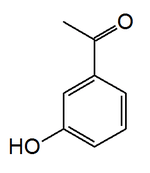3-Hydroxyacetophenone
 | |
| Names | |
|---|---|
| Preferred IUPAC name
1-(3-Hydroxyphenyl)ethan-1-one | |
| Other names
1-(3-Hydroxyphenyl)ethanone 3-Acetylphenol m-Hydroxyacetophenone 3'-Hydroxyacetophenone | |
| Identifiers | |
| 121-71-1 | |
| 3D model (Jmol) | Interactive image |
| ChemSpider | 8174 |
| ECHA InfoCard | 100.004.086 |
| PubChem | 8487 |
| |
| |
| Properties | |
| C8H8O2 | |
| Molar mass | 136.15 g·mol−1 |
| Density | 1.099 g/cm3 |
| Melting point | 96 °C |
| Boiling point | 296 °C |
| Except where otherwise noted, data are given for materials in their standard state (at 25 °C [77 °F], 100 kPa). | |
| Infobox references | |
3-Hydroxyacetophenone is a chemical compound. It is a component of castoreum, the exudate from the castor sacs of the mature beaver.[1]
Related compounds
Humans excrete small amounts of conjugated 2-amino-3-hydroxyacetophenone, a product of tryptophan metabolism, in the urine.[2]
The plant Chrysothamnus viscidiflorus (Asteraceae) contains an m-hydroxyacetophenone named viscidone.[3]
See also
References
- ↑ Müller-Schwarze, D.; Houlihan, Peter W. (1991). "Pheromonal activity of single castoreum constituents in beaver, Castor canadensis". Journal of Chemical Ecology. 17 (4): 715–34. doi:10.1007/BF00994195. PMID 24258917.
- ↑ Dalgliesh, CE (1955). "Excretion of conjugated 2-amino-3-hydroxyacetophenone by man, and its significance in tryptophan metabolism". Biochemical Journal. 61 (2): 334–337. PMC 1215790
 . PMID 13260216.
. PMID 13260216. - ↑ Ngo, le-van; Thi, Van Cuong Pham (1981). "An unusual m-hydroxyacetophenone and three new chromanone derivatives from Chrysothamnus viscidiflorus". Phytochemistry. 20 (3): 485. doi:10.1016/S0031-9422(00)84171-0.
This article is issued from Wikipedia - version of the 9/6/2016. The text is available under the Creative Commons Attribution/Share Alike but additional terms may apply for the media files.